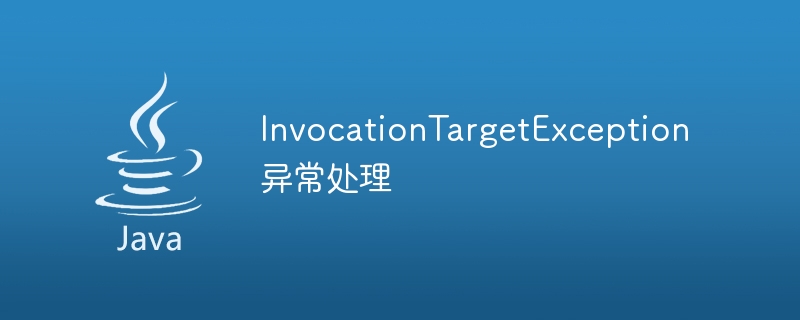InvocationTargetException exception handling
InvocationTargetException exception handling steps: 1. Get the root cause of the exception through the "getCause()" method of InvocationTargetException; 2. Use the "printStackTrace()" method of InvocationTargetException to print exception information; 3. You can use try -catch statement to capture root cause exceptions; 4. Distinguish between business exceptions and system exceptions.

InvocationTargetException is an exception type in Java. It usually occurs when a method is called reflectively. The called method throws an exception but is not caught. This exception will be wrapped into InvocationTargetException and re-thrown.
The method of handling InvocationTargetException exception is as follows:
View the root cause:
InvocationTargetException is a wrapper exception, which usually contains the method thrown by the called method specific exception. You can obtain the root cause of the exception through the getCause() method of InvocationTargetException, and then handle it according to the exception type of the root cause. For example:
try {
// 反射调用方法
} catch (InvocationTargetException e) {
Throwable cause = e.getCause();
if (cause instanceof SomeException) {
// 处理SomeException异常
} else if (cause instanceof AnotherException) {
// 处理AnotherException异常
} else {
// 处理其他异常
}
}Print exception information:
You can use the printStackTrace() method of InvocationTargetException to print exception information to facilitate debugging and problem location. For example:
try {
// 反射调用方法
} catch (InvocationTargetException e) {
e.printStackTrace();
}Handling root cause exceptions:
Depending on the root cause exception type, different handling methods can be adopted. You can use try-catch statements to catch the root cause of exceptions and handle them accordingly. For example:
try {
// 反射调用方法
} catch (InvocationTargetException e) {
Throwable cause = e.getCause();
try {
throw cause;
} catch (SomeException se) {
// 处理SomeException异常
} catch (AnotherException ae) {
// 处理AnotherException异常
} catch (Exception ex) {
// 处理其他异常
}
}Distinguish between business exceptions and system exceptions:
When handling InvocationTargetException exceptions, the root cause exceptions can be divided into business exceptions and system exceptions. Business exceptions are exceptions that may occur during the normal operation of the program and can be processed according to business logic; system exceptions are exceptions caused by program errors or external environment problems, which generally require logging and alarming. You can use the instanceof keyword to determine the exception type and then handle it separately.
try {
// 反射调用方法
} catch (InvocationTargetException e) {
Throwable cause = e.getCause();
if (cause instanceof BusinessException) {
// 处理业务异常
} else {
// 处理系统异常,记录日志并告警
}
}Summary
The key to handling the InvocationTargetException exception is to obtain the root cause of the exception and handle it accordingly. The root cause of the exception can be obtained through the getCause() method, and then the handling method can be selected based on the exception type of the root cause. In addition, you can also print exception information, distinguish business exceptions and system exceptions, etc.
The above is the detailed content of InvocationTargetException exception handling. For more information, please follow other related articles on the PHP Chinese website!

Hot AI Tools

Undresser.AI Undress
AI-powered app for creating realistic nude photos

AI Clothes Remover
Online AI tool for removing clothes from photos.

Undress AI Tool
Undress images for free

Clothoff.io
AI clothes remover

AI Hentai Generator
Generate AI Hentai for free.

Hot Article

Hot Tools

Notepad++7.3.1
Easy-to-use and free code editor

SublimeText3 Chinese version
Chinese version, very easy to use

Zend Studio 13.0.1
Powerful PHP integrated development environment

Dreamweaver CS6
Visual web development tools

SublimeText3 Mac version
God-level code editing software (SublimeText3)

Hot Topics
 1377
1377
 52
52
 How does Java's classloading mechanism work, including different classloaders and their delegation models?
Mar 17, 2025 pm 05:35 PM
How does Java's classloading mechanism work, including different classloaders and their delegation models?
Mar 17, 2025 pm 05:35 PM
Java's classloading involves loading, linking, and initializing classes using a hierarchical system with Bootstrap, Extension, and Application classloaders. The parent delegation model ensures core classes are loaded first, affecting custom class loa
 How do I implement multi-level caching in Java applications using libraries like Caffeine or Guava Cache?
Mar 17, 2025 pm 05:44 PM
How do I implement multi-level caching in Java applications using libraries like Caffeine or Guava Cache?
Mar 17, 2025 pm 05:44 PM
The article discusses implementing multi-level caching in Java using Caffeine and Guava Cache to enhance application performance. It covers setup, integration, and performance benefits, along with configuration and eviction policy management best pra
 How can I use JPA (Java Persistence API) for object-relational mapping with advanced features like caching and lazy loading?
Mar 17, 2025 pm 05:43 PM
How can I use JPA (Java Persistence API) for object-relational mapping with advanced features like caching and lazy loading?
Mar 17, 2025 pm 05:43 PM
The article discusses using JPA for object-relational mapping with advanced features like caching and lazy loading. It covers setup, entity mapping, and best practices for optimizing performance while highlighting potential pitfalls.[159 characters]
 How do I use Maven or Gradle for advanced Java project management, build automation, and dependency resolution?
Mar 17, 2025 pm 05:46 PM
How do I use Maven or Gradle for advanced Java project management, build automation, and dependency resolution?
Mar 17, 2025 pm 05:46 PM
The article discusses using Maven and Gradle for Java project management, build automation, and dependency resolution, comparing their approaches and optimization strategies.
 How do I create and use custom Java libraries (JAR files) with proper versioning and dependency management?
Mar 17, 2025 pm 05:45 PM
How do I create and use custom Java libraries (JAR files) with proper versioning and dependency management?
Mar 17, 2025 pm 05:45 PM
The article discusses creating and using custom Java libraries (JAR files) with proper versioning and dependency management, using tools like Maven and Gradle.




